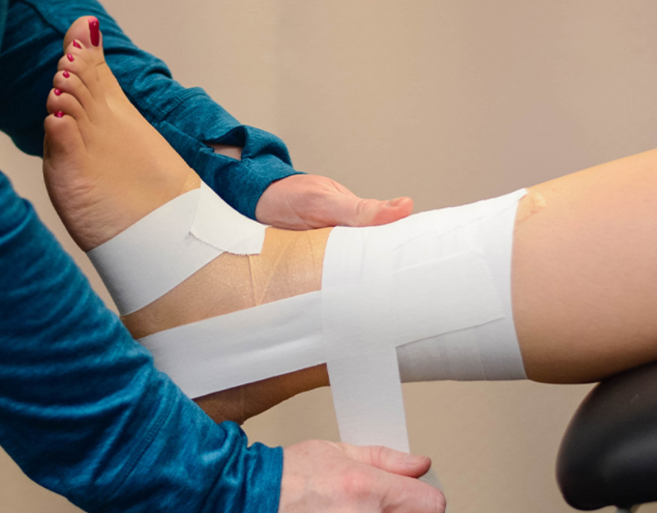Ankle Taping Methods

Here is a comprehensive guide to the athletic taping method for football ankle protection, covering the most common and effective techniques. By using the correct technique, football players can significantly reduce their risk of ankle sprains and play with more confidence.
Method 1: The Standard Closed Basketweave (Most Common for Football)
This is the gold standard for providing strong mechanical support and limiting excessive inversion (rolling the ankle outward) and eversion.
What You'll Need:
1.5" or 2" Athletic Tape: (e.g., Coach or Leukotape)
Pre-wrap: (e.g., Pre-wrap) to protect the skin. (Optional but recommended for daily use).
Heel and Lace Pads: (Optional) small foam pads to prevent blisters on the Achilles tendon and over the foot bones.
Tape Spray: Adhesive spray (e.g., Tuf-Skin) can help the tape stick better, especially if pre-wrap is used.
Scissors.
Preparation:
Skin: The ankle and foot should be clean, dry, and free of lotions or oils.
Hair: Shaving the area is recommended for better adhesion and less discomfort on removal.
Position: Have the athlete sit on a table with their foot hanging off the edge, relaxed at a 90-degree angle. CRUCIAL: Do not have them point their toe during application, as this will tighten the tape when the foot returns to neutral.
Step-by-Step Application:
Step 1: Anchor Strips
Apply a single strip of pre-wrap around the mid-calf, about 6 inches above the ankle bone. Do not wrap too tightly.
Apply a second single strip around the ball of the foot (the metatarsal heads).
Optional: Spray adhesive over the pre-wrap.
Step 2: Stirrups (Primary Stability)
Stirrup 1: Start from the inside of the calf anchor, travel down under the heel, and finish on the outside of the calf anchor. This pull should be firm and support the ankle against inversion.
Stirrup 2: Start from the outside of the calf anchor, travel down under the heel, and finish on the inside of the calf anchor. This supports against eversion.
Continue applying 3-4 stirrups total, overlapping the previous one by about half the tape's width. Place the first stirrup slightly toward the back of the heel, and the subsequent ones moving forward.
Step 3: Horseshoes (Horizontal Support)
Horseshoe 1: Start on the outside of the foot, just above the ankle bone, travel behind the Achilles tendon, and finish just above the inside ankle bone.
Apply 3-4 horseshoes, moving upward to cover the stirrups. Each horseshoe should overlap the previous one.
Step 4: Figure-Six (Locking the Heel)
This is a critical lock for football players making cuts.
Start on the inside of the calf, high up. Pull the tape diagonally down across the front of the ankle, under the arch of the foot.
Continue pulling the tape behind the heel, and then diagonally back up across the front of the ankle to the outside of the calf where you started, forming a "6" or "G" shape.
Step 5: Closing the Tape Job
Heel Lock: Apply another Figure-Six in the opposite direction for added stability.
Fill-In: Use continuous strips of tape to cover the entire taped area from the top of the horseshoes down to the ball of the foot, creating a solid "cast."
Final Anchors: Apply a final anchor strip around the mid-calf and the ball of the foot to secure all the loose ends.
Method 2: The Hybrid Method (Tape + Bracing)
Many football players and trainers now use a combination for superior protection and cost-effectiveness.
Apply a Basic Stirrup/Horseshoe: Apply just 2-3 stirrups and 2-3 horseshoes. This provides a base layer of support.
Apply a Hinged Ankle Brace: Slip a commercially made lace-up or hinged ankle brace over the basic tape job.
This combines the custom fit and skin protection of tape with the superior mechanical stopping power of modern braces.
Key Considerations for Football Players
Prevention vs. Rehabilitation: The taping method for a previously injured ankle will be much more rigid and extensive than for preventive support on a healthy ankle.
Position Needs:
Linemen: Benefit from maximum stability and restriction to withstand constant pushing.
Skill Positions (WRs, RBs, DBs): Need a balance of support and flexibility to make cuts and accelerate. A slightly less restrictive job or a hybrid method is often preferred.
Tape Doesn't Replace Strength: Taping is a external aid. It should be used in conjunction with a strong ankle strengthening program (e.g., calf raises, resistance band exercises).
Removal: Always use tape scissors to cut the tape. Never just rip it off. Cut along the inside of the foot and up the back of the Achilles to safely remove the "shell."
